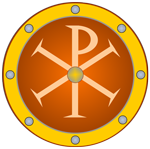
Siege of Ariminum(Siege of Rimini) |
year: 538 |
| Ineffective siege of Byzantine-occupied Ariminum (Rimini) by the Ostrogoths | ★ ★ ★ ★ ★ |
|
enemy: Ostrogoths
|
location: Ariminum, present-day Rimini in Italy
|
accuracy:
●●●●●
|
|
battle type: Siege |
war: Gothic War in Italy |
modern country:
Italy |
| ▼ The Byzantines(emperor: Justinian I) | ▼ The Enemies | |
| Commander: | John | King Vitiges |
| Forces: | 3,400 | |
| Losses: |
| Background story: |
| General Belisarius conquered Rome without a fight in December 536. The following March, the Ostrogoths returned and besieged the city with a large army. Belisarius managed to defend successfully for almost a year and, despite the great numerical advantage of the Goths, it was clear that the siege was doomed to fail. One of the tactics of Belisarius, especially towards the end of the siege, was to send forces to the rear of the besiegers and to occupy positions and fortresses cutting off the supply lines of the enemy. As part of these distraction raids, Belisarius sent an officer, John (nephew of the notorious rebel Vitalianus), with 2,000 Isaurian horsemen to the province of Picenum northeast of Rome. John began looting and slaughtering civilians in this area and defeated an army of Goths who tried to stop him. Going further north, John reached Auximus (Osimo), a city with a strong castle which he estimated that it would be difficult to capture, so he bypassed it and reached Urbinus (Urbino) which also bypassed for the same reason. The ambitious John did not want to waste time in castle sieges. After all, having only cavalry, he was not properly prepared for sieges. So he took the initiative to turn against the important city and port of Ariminum, today's Rimini. The city was a day’s distance from Ravenna, where Vitiges, king of the Ostrogoths, was based. John believed - rightly as it turned out - that if he took Ariminum, the Ostrogoths would be forced to rush there with all their forces and abandon the siege of Rome. When John and his cavalry approached Ariminum, the small Gothic guard stationed in the city thought it was the vanguard of Belisarius’ army. So they put up no resistance and left the city. Thus, beyond all expectations, John found himself the lord of Ariminum, but had left behind two strong enemy fortresses, which was contrary to the orders of Belisarius. As predicted by John, the Ostrogoths had to leave Rome and focus on Rimini, where the threat was imminent. These developments made a great impression and were considered a great achievement of John, who already had a reputation as an excellent warrior. Belisarius, however, did not seem to be particularly amused with John’s sudden glory. Belisarius, knowing that the Ostrogoths would besiege Ariminum, sent reinforcements of 1000 men led by Generals Ildiger and Martinos. Apparently Belisarius did not want to keep 2000 excellent cavalry, who would be invaluable in open warfare, shut up in Ariminum, and only tempting the Goths to besiege it. So he wanted to replace them with other forces more experienced in city defense. Indeed, Ildiger and Martinos arrived in Ariminum after passing through Ancona where they took 400 infantry. But John, disobeying the orders of Belisarius, refused to leave and hand over the command of the besieged city. After that, Ildiger and Martinos left, leaving behind the reinforcements they had brought with them. |
The Battle: |
 ancient Ariminum At the beginning of the siege, the Ostrogoths built a large wooden siege tower that was taller than the walls. To move it near the fortification, the tower was dragged by soldiers instead of oxen (because in Rome the Byzantines had shot the oxen and the siege engines had become useless). But at night, John himself came out of the walls and with a group of Isaurians dug a trench along the walls to prevent the siege engine from approaching. The next morning the Goths were surprised. To cover the trench, they filled it with faggots, but when the huge tower tried to pass, the layer of fillings receded and the tower stuck. The Goths decided to withdraw and began to pull back the siege tower. Then John attacked. A bloody battle ensued in which the Goths suffered heavy losses, although the Byzantines failed to destroy the tower. Vitiges after the embarrassing incident with the siege machine and having suffered serious losses decided to stop the attacks on the walls and instead to blockade the city, that was unprepared for a long siege and did not have sufficient supplies. This also enabled him to release part of his forces to strengthen the defense on other fronts where Belisarius was trying to advance. This plan worked better and the city after a few weeks began to suffer from hunger and lack of supplies. It was obvious that it could not resist for long if help did not come in time from the Byzantine army. At that time, after the end of the siege of Rome, the war with the Goths had shifted to central and northern Italy. Belisarius was advancing north slowly and methodically, occupying one by one the fortresses of the Goths. The advantage of the Byzantines was further strengthened when new reinforcements arrived from Byzantium of 7,000 men (5000 Isaurians + 2000 Heruls) led by the eunuch Narses. This development seriously strengthened the Byzantine military power in Italy, but created confusion as to who would actually be the head of operations in Italy from now on. Belisarius was not willing to intervene to alleviate the siege of Ariminum, considering that in an advance to Ariminum with the stronghold of Auximus in the rear, his army would be exposed and vulnerable. Besides, John had found himself in this difficult position due to his own disobedience. At a meeting of the commanders of the army, most agreed with this logic. But not Narses, who insisted that they should not let Ariminum fall. He even went so far as to hint that Belisarius would be accused for disobedience to the king if he did not act. Then an envoy from John arrived, who managed to cross the enemy lines, bringing a letter to the general, informing him that if help did not come, he would be forced to surrender within seven days and no one would have the right to blame him. Belisarius was finally persuaded that he had to save Rimini. And from the moment he decided, he moved as always with impeccable tactics and with extreme efficiency. Belisarius divided his army into four divisions. He left a unit with 1000 men as a rearguard to guard its rear towards Auximus. A large force was sent by sea to Ariminum under Ildiger, who was ordered not to disembark until another unit marching along the coast, led by Martinos, reached the city.Martinos was instructed when he would approach Ariminum to light many fires on the mountain to give the enemy the impression of a large army. Belisarius, accompanied by Narsis, led the rest of the army through the mountains to reach there from the northwest. For the complete success of the plan it was necessary that the convergence of the three armies on the city should be timed to coincide. During the march of Belisarius, a skirmish took place with a group of Goths who fled and took refuge in Ariminum where they informed the Ostrogoth leaders that Belisarius was coming with a large army. Immediately the Ostrogoths lined up for battle on the north side of the city and spent the day waiting for Belisarius to appear from the hills to the northwest. When night fell and they relaxed, they suddenly saw on the opposite side, to the southeast, the many fires that had been lit by Martinos’ soldiers. The Goths realized that they were in danger of being surrounded, and passed the night in fear. When morning came and they looked out to sea, they saw a fleet of hostile ships approaching. All this was too much and the Goths broke up their camp and hurried to leave for Ravenna. In fact, if the city guard had not been so exhausted and chased them, the war would have ended that day. But John's unit was too weak to to seize the moment. Ildiger and the troops that came with the fleet were the first to arrive at the abandoned camp of the barbarians. Belisarius arrived later, at noon. When Belisarius met John, pale and weak, he remarked that he ought to thank Ildiger. John dryly replied that his gratitude was due only to Narses. |
Aftermath: |
| The Byzantine ops continued for the next two years with success. The war was now a series of sieges and captures of castles. The bad thing was that the army was split in two. Half were with Belisarius and the others with Narses and John, who acted independently for a while. This lasted for a few months when Narses and John failed to help the city of Milan resulting in the sack of the city by the enemy. After that, Narses was recalled. He came back to Italy 12 years later. |
|
|
